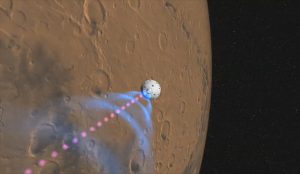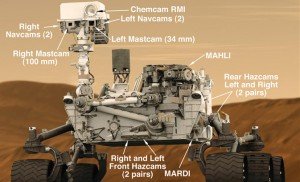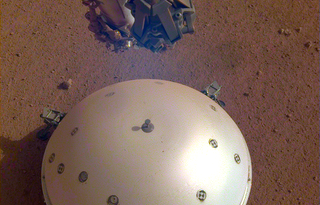Mars, baby! It’s the freakiest show.
Apologies to David Bowie, but now that NASA has successfully landed Curiosity on the Red Planet, the question we’re asking here is, is there life on Mars? Yes, we’re cracking the champers open at Casa Crowsnest. What an achievement!

The Mars Science Laboratory spacecraft that carried Curiosity succeeded in the most complex touch-down ever attempted on the Red Planet, including the final severing of the cords and flyaway action of the rocket backpack. The one-ton rover, hanging by ropes from a rocket backpack like some crazy mechanical Rocketeer, finally touched down onto Mars last night, finishing its thirty six weeks of flight and getting ready for some serious science.
Curiosity landed at 10:32 p.m last night close to the foot of a mountain three miles tall and 96 miles in diameter, inside Gale Crater. During its minimum two-year mission (it should be much longer, in reality), the rover will investigate whether the region ever offered conditions favourable for microbial life.
Curiosity returned its first view of Mars, a wide-angle scene of rocky ground near the front of the rover.

More images are anticipated in the next several days as the mission blends observations of the landing site with activities to configure the rover for work and check the performance of its instruments and mechanisms.
Curiosity carries ten science instruments with a total mass 15 times as large as the science payloads on the Mars rovers Spirit and Opportunity. Some of the tools are the first of their kind on Mars, such as a laser-firing instrument for checking elemental composition of rocks from a distance. The rover will use a drill and scoop at the end of its robotic arm to gather soil and powdered samples of rock interiors, then sieve and parcel out these samples into analytical laboratory instruments inside the rover.
To handle this science toolkit, Curiosity is twice as long and five times as heavy as Spirit or Opportunity. The Gale Crater landing site places the rover within driving distance of layers of the crater’s interior mountain. Observations from orbit have identified clay and sulfate minerals in the lower layers, indicating a wet history.

“Today, the wheels of Curiosity have begun to blaze the trail for human footprints on Mars. Curiosity, the most sophisticated rover ever built, is now on the surface of the Red Planet, where it will seek to answer age-old questions about whether life ever existed on Mars – or if the planet can sustain life in the future. This is an amazing achievement, made possible by a team of scientists and engineers from around the world and led by the extraordinary men and women of NASA and our Jet Propulsion Laboratory. President Obama has laid out a bold vision for sending humans to Mars in the mid-2030’s, and today’s landing marks a significant step toward achieving this goal,” said NASA’s Charles Bolden.
“The Seven Minutes of Terror has turned into the Seven Minutes of Triumph. My immense joy in the success of this mission is matched only by overwhelming pride I feel for the women and men of the mission’s team,” added NASA scientist John Grunsfeld.



